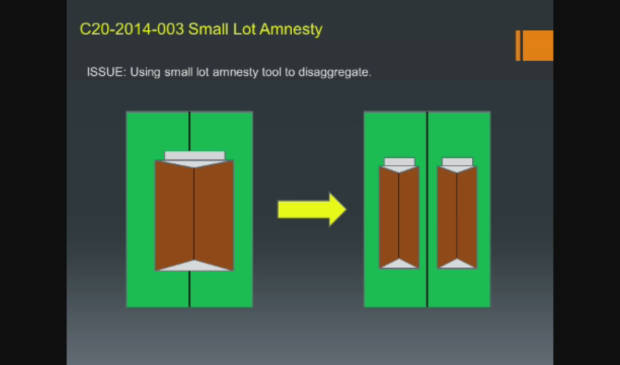Small-lot code fix divides commissioners
Thursday, January 7, 2016 by
Elizabeth Pagano Plans to tighten the city’s code to prevent an unintended use of the city’s small-lot amnesty provision are moving to City Council without a recommendation from the Planning Commission.
Small-lot amnesty allows the development of lots as small as 2,500 square feet for neighborhoods that have opted in to the standards in their neighborhood plans. At present, developers can use the tool to demolish existing homes built over two substandard lots and replace them with two homes. The city is now considering closing that loophole and amending the code so that the provision is in line with the original intent to allow homes on small lots to undergo major repairs and allow development on small lots. The change will prohibit small-lot amnesty from being used when a site is broken down into several contiguous substandard lots.
The code amendment was unanimously initiated by the previous Planning Commission less than a year ago.
The new Planning Commission was much less unified on the subject and failed to find the required seven votes either for or against the changes, so the proposed code amendments will move forward without a recommendation.
Planning and Zoning Department Senior Planner Greg Dutton explained at the commission’s Dec. 8 meeting that while urban infill is important, that just wasn’t what neighborhoods signed up for when they agreed to include the amnesty tool in their neighborhood plans. He told the commission that “many neighborhoods” have expressed concern with how the tool is currently being used.
“It was never sold as something where you could increase density by tearing down one house and putting up multiple, smaller houses. It was called amnesty because it was granting amnesty for an existing situation where you could not build or redevelop on a single lot,” said Dutton. “It’s kind of a truth-in-advertising kind of thing.”
Commissioner Trinity White pointed out that there were other tools offered to neighborhoods at the same time they adopted small-lot amnesty that would serve the role that amnesty is now unintentionally filling. The difference, she said, is that those other tools have restrictions on new development in terms of design standards and compatibility.
“I think it’s very clear that the neighborhoods already said they were uninterested in that loophole,” said White. “Otherwise they would have accepted the cottage lot infill tool and the urban home infill tool.”
“Depending on a loophole is deceitful,” said White.
As it stands, she noted, only five neighborhoods have chosen to embrace those tools. “Many many more neighborhoods said, ‘We’re not interested in doing those smaller lots. But, we want to be good neighbors to the people who are already here. We want to make sure that the person who already lives on a smaller lot can fix their roof.’ Because that’s what this tool does. That’s the intention behind this tool,” said White.
In contrast, Commissioner Jose Vela said he “really didn’t like this proposal” and took issue with the idea that neighborhoods didn’t know what they were agreeing to.
“Maybe they didn’t think about it at the time, because it was a totally different economy and a totally different city 15 years ago, but that ordinance language has not changed,” said Vela. “To me, we are taking wealth away from a lot of the brown and black families on the East Side that have these small lots that they could potentially disaggregate and use and sell and make some money on. … On every level, I think this is a bad amendment.”
Vela continued, “It’s bad for affordability. It goes contrary to our comprehensive plan. I just see this as a solution in search of a problem. I just don’t understand why we need this, where we are going with this (and) what the goals are. It does not advance any goals I can think of.”
Commissioner James Shieh saw things differently. He explained that there were other tools that would allow that kind of redevelopment, but those tools would also have to be agreed upon by the neighborhood. As it stands now, he explained, neighborhoods agreed to one thing but are getting another because of a loophole.
“We kind of led the public astray,” said Shieh. “Doing it like this and kind of sliding it in – I don’t think that’s right.”
Zilker resident David King agreed with Shieh’s take, saying, “If we want this to happen, then we should initiate a code amendment that explicitly allows this to happen and go through a public process. … I think that’s the fair thing to do.”
David Whitworth, who serves on the city’s Historic Landmark Commission and is a developer, spoke against the code amendment. He said that small-lot amnesty was a tool that helps with building additional homes using older, platted lots. To remove the ability to disaggregate small lots “throws away half the capacity of Austin’s original neighborhoods,” he said.
Whitworth suggested that, as a solution, the amnesty could go through the neighborhood planning process again, with a better explanation about what could be done if neighborhoods opted to use the tool.
You're a community leader
And we’re honored you look to us for serious, in-depth news. You know a strong community needs local and dedicated watchdog reporting. We’re here for you and that won’t change. Now will you take the powerful next step and support our nonprofit news organization?










